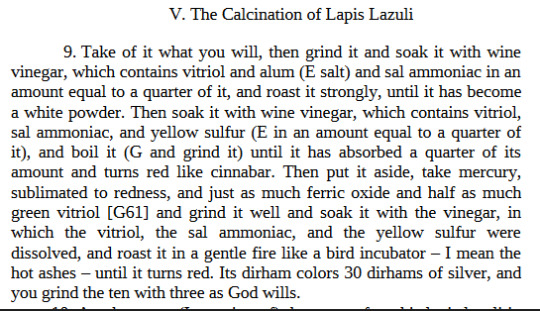#Hey did you know Cyprus was exporting sulfuric acid from Roman-era AMD??????
Explore tagged Tumblr posts
Text
It is really really really really really interesting to read these old chemistry guides with a knowledge of geology. By functionally ignoring the words and focusing on the reactions that are happening, you can piece together the real minerals despite the translators' struggles for the right word.

Like here, "Zungufr" is clearly "red ????". The translators (there were two translations before this one) likely didn't have a knowledge of mineralogy. From the rest of the text, I'm fairly certain Copper acetate is either Copper Acetate or Copper Nitrate, to be added with (NH)4Cl and Malachite (Hydrated Copper Carbonate). However, the end result via the translator is Cinnabar - which is a theoretically reasonable guess. Natural cinnabar is red, and so is arsenic sulfide. However, there's literally no As or Hg in this equation, which means that the result is the red Copper Oxide mineral, CuO. Cuprite.

Likewise, you have "The Calcination of Lapis Lazuli", which I thought was interesting in the first place, because in the beginning of the text, Al-Razi describes all the reagents. (21) The translator decided to stick with Lapis Lazuli, although seemingly aware that Azurite and Lapis Lazuli are not even close to the same mineral.



However, when you look at the minerals in 21, something doesn't add up. I was already suspicious of the Lapis Lazuli description, but something was clearly wrong in 21. Neither Lapis nor Hematite have copper, or are "oily/vitreous" minerals. Plus, they already described "Iron Oxides" above this point. Which makes it much more likely that "Lapis Lazuli" actually means Azurite, and Hematite is actually describing Sphalerite, (Zn,Fe)S, and Al-Razi prefers the Fe-rich Sphalerite.
This was also supported by his description of several "zinc ore" minerals, but I couldn't find a good description of sphalerite among them. Then I realized that what Al-Razi was really describing were different variations of Zinc Oxides, and separating out Zinc Sulfides.

Talc does NOT glitter. And there's no reason to differentiate "sea-talc" and "mountain-talc". But there would be if you knew there were Fe-Micas and Mg-Micas! (Or even just the straight Al-Mica.)
But to be clear, this is not the fault of the translators!! The fact they got close enough I can recognize the errors and described the mineral well enough I can recognize these reactions are a blessing in and of itself.
#archeometallurgy#archeochemistry#mineralogy#I'm having so much fun. I've been reading all day and it's killing me but I'm so excited. And this is important!!!#'so and so described X mineral in 1549' No they fucking didn't. I just read how to amalgum Au out of arsenopyrite from 900AD!!!#They might've called it yellow marcasite but they knew what they were doing.#Anyway I still haven't gotten to the part with Copper Smelting which is theoretically the only part I care about. xDDD#Hey did you know Cyprus was exporting sulfuric acid from Roman-era AMD??????#It's just a pity that some people will look at that Lapis reaction and think that Al-Razi didn't know what he was talking about.#No he DEFINITELY did.
2 notes
·
View notes